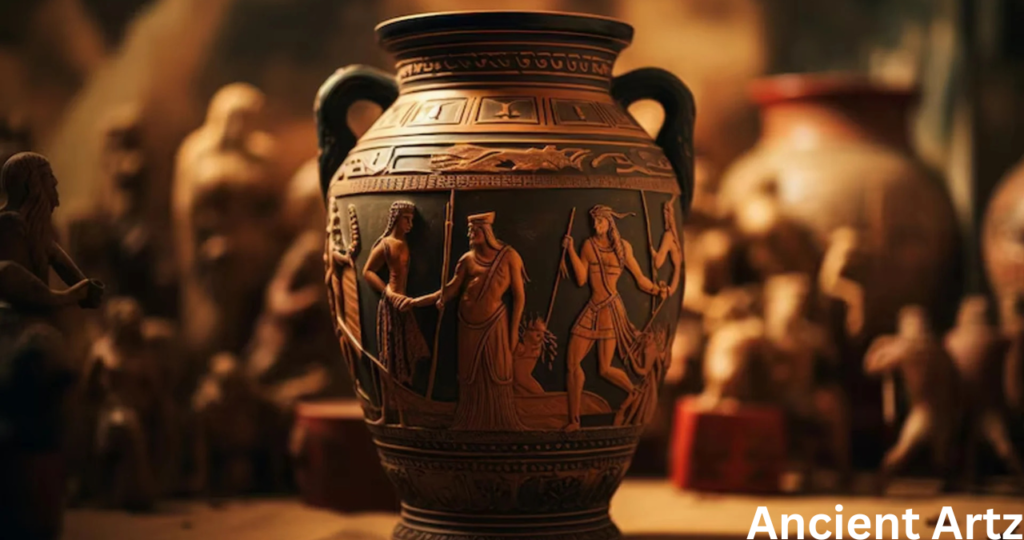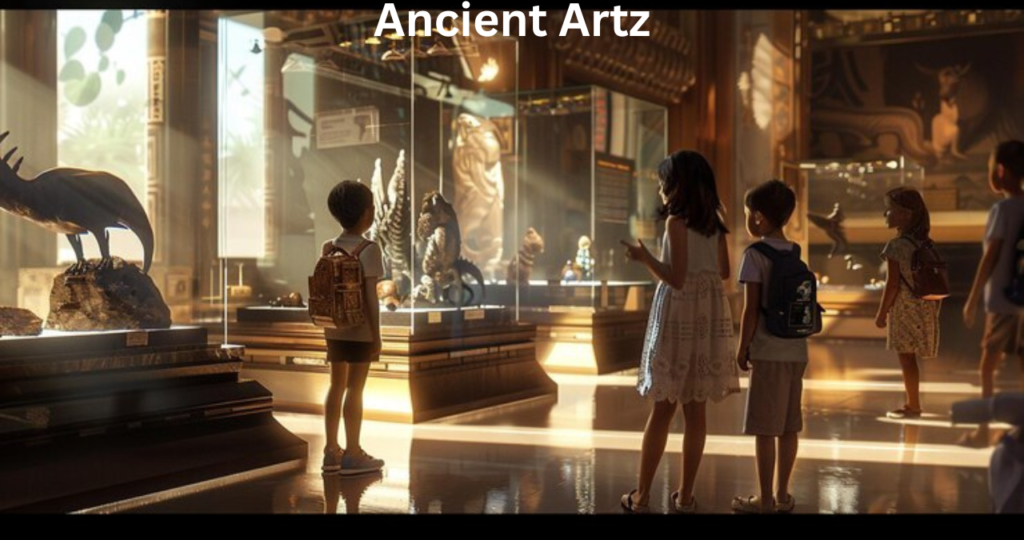Ancient Artz stands as a testament to the creative genius of early civilizations. From the walls of prehistoric caves to the grand temples of Egypt, Mesopotamia, Greece, and beyond, ancient art provides a window into humanity’s past. It not only reflects the cultural and religious beliefs of early societies but also lays the foundation for modern artistic expression. By studying ancient art, we gain valuable insights into the evolution of creativity, symbolism, and aesthetics that continue to inspire contemporary artists. This article explores the origins, major civilizations, techniques, and lasting influence of ancient art.
The Origins of Ancient Artz

The history of Ancient Artz dates back to prehistoric times when early humans used rudimentary materials to create symbolic representations of their lives. The earliest known artistic expressions are cave paintings and petroglyphs, which date back over 40,000 years. These early artworks, discovered in caves across Europe, Africa, and Asia, depict hunting scenes, animals, and abstract symbols. Archaeologists believe that these drawings were not merely decorative but held spiritual or ritualistic significance.
As human societies evolved, so did their artistic techniques. The transition from the Stone Age to the Bronze Age saw advancements in sculpture, pottery, and architectural design. The invention of writing further enhanced artistic expression, allowing civilizations to document their histories and beliefs through carvings and inscriptions. Ancient art, therefore, represents the earliest form of human storytelling, capturing the essence of civilizations long gone.
Major Ancient Artz Civilizations and Their Contributions
Egyptian Art: Symbolism and Immortality

Egyptian art is renowned for its highly stylized and symbolic nature. From massive pyramids to intricate tomb paintings, every piece of Egyptian art served a specific purpose. The ancient Egyptians believed in the afterlife, and much of their artwork was created to ensure a smooth transition to the next world. Hieroglyphics, temple reliefs, and sculptures of gods and pharaohs were designed to preserve history and honor deities.
Egyptian artists followed strict conventions in their depictions of the human figure. Their characteristic frontal and profile views were not just stylistic choices but also held religious and social significance. The use of vibrant colors, precious materials, and intricate carvings made Egyptian art one of the most visually striking artistic traditions in history. Even today, the treasures of Tutankhamun and the grandeur of the pyramids continue to fascinate and inspire.
Mesopotamian Art: The Cradle of Civilization
Mesopotamia, often referred to as the “Cradle of Civilization,” gave birth to some of the earliest artistic achievements. The Sumerians, Babylonians, and Assyrians created breathtaking relief sculptures, cylinder seals, and monumental ziggurats. Cuneiform inscriptions carved into clay tablets provided one of the first written records in human history.
One of the most famous Mesopotamian artworks is the Stele of Hammurabi, which depicts the Babylonian king receiving laws from the god Shamash. The Assyrians, known for their warlike nature, created elaborate palace reliefs showcasing battles and hunting scenes. The combination of realism, symbolism, and storytelling in Mesopotamian art has left a lasting impact on the art world.
Greek and Roman Art: Foundations of Classical Aesthetics
The Greeks revolutionized artistic expression by emphasizing realism, proportion, and harmony. Unlike the rigid styles of Egyptian and Mesopotamian art, Greek sculptures captured movement and emotion, making them appear lifelike. From the idealized beauty of the Parthenon sculptures to the dramatic expressions in Hellenistic art, Greek art set the standard for Western aesthetics.
The Romans, inspired by Greek art, expanded upon these traditions by incorporating realism into their portraits and sculptures. Frescoes from Pompeii, elaborate mosaics, and grand architectural feats like the Colosseum highlight the artistic achievements of Rome. The classical influence of Greek and Roman art continues to shape modern architecture, sculpture, and design.
Indian and Chinese Ancient Art: Spiritual and Philosophical Reflections
In India, Ancient Artz was deeply intertwined with religion and spirituality. The rock-cut temples of Ajanta and Ellora, intricate Hindu temple carvings, and serene Buddha statues illustrate the country’s devotion to art as a means of storytelling and worship. The influence of Buddhist art extended to China, Japan, and Southeast Asia, where similar artistic motifs evolved.
Ancient Chinese art, on the other hand, focused on calligraphy, ink paintings, and pottery. The famous Terracotta Army of Emperor Qin Shi Huang showcases the precision and craftsmanship of Chinese sculptors. Calligraphy, considered the highest form of art in China, demonstrated the harmonious relationship between aesthetics and philosophy.
Techniques, Materials, and Innovations in Ancient Art

Ancient Artz used a variety of materials to create their masterpieces, including stone, clay, metal, and natural pigments. Egyptian artists used limestone and gold, Mesopotamians carved in basalt and alabaster, while Greek and Roman sculptors preferred marble and bronze.
Techniques such as fresco painting, relief carving, and mosaic inlay allowed for intricate and durable works of art. The development of perspective, depth, and anatomical accuracy in Greek and Roman art showcased the continuous evolution of artistic skills. These techniques laid the groundwork for future artistic innovations.
The Influence of Ancient Art on Modern and Contemporary Works
Ancient art’s impact is evident in various art movements, from the Renaissance to contemporary design. During the Renaissance, artists like Michelangelo and Leonardo da Vinci drew inspiration from Greek and Roman sculptures, reviving classical techniques. The neoclassical movement of the 18th century further emphasized the grandeur of ancient art.
Today, museums, galleries, and academic institutions continue to study and preserve ancient artworks. Many modern artists incorporate ancient motifs and styles into their work, proving that the legacy of ancient art remains alive. The timeless beauty and craftsmanship of ancient artworks continue to inspire and educate generations of artists and historians.
Conclusion
Ancient Artz is more than just a historical artifact—it is a bridge between past and present, revealing the thoughts, beliefs, and aspirations of early civilizations. From the grandeur of Egyptian pyramids to the elegance of Greek sculptures, ancient art continues to captivate and influence the world. Preserving and studying these masterpieces allows us to appreciate the artistic achievements of our ancestors and understand the roots of human creativity. As we move forward, ancient art remains an eternal source of inspiration and knowledge.
Frequently Asked Questions (FAQs)
What defines Ancient Artz, and how is it different from modern art?
Ancient Artz refers to artistic creations from early civilizations, often focused on religious, political, and cultural themes. Unlike modern art, which embraces diverse styles, ancient art adhered to strict conventions and symbolism.
What are some of the most famous ancient artworks still preserved today?
Notable examples include the Pyramids of Giza, the Parthenon sculptures, the Terracotta Army, and the Stele of Hammurabi.
How do historians and archaeologists study ancient art?
They analyze artifacts, inscriptions, and architectural remains to interpret cultural and historical contexts. Advanced techniques like carbon dating and 3D scanning aid in research.
Why is ancient art important in today’s world?
Ancient art provides insight into past civilizations, influencing contemporary art, architecture, and culture. It also serves as a reminder of humanity’s enduring creativity and expression.






